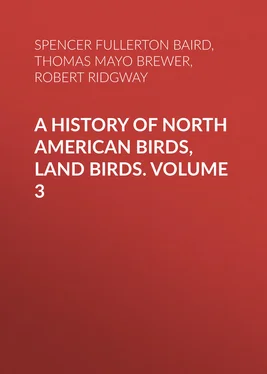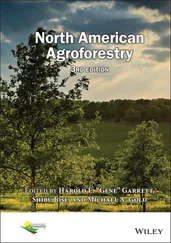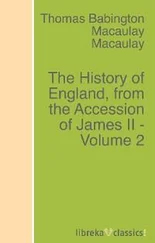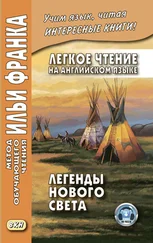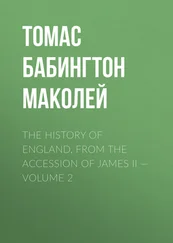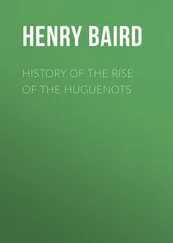Spencer Fullerton Baird - A History of North American Birds, Land Birds. Volume 3
Здесь есть возможность читать онлайн «Spencer Fullerton Baird - A History of North American Birds, Land Birds. Volume 3» — ознакомительный отрывок электронной книги совершенно бесплатно, а после прочтения отрывка купить полную версию. В некоторых случаях можно слушать аудио, скачать через торрент в формате fb2 и присутствует краткое содержание. Жанр: foreign_antique, Биология, foreign_edu, на английском языке. Описание произведения, (предисловие) а так же отзывы посетителей доступны на портале библиотеки ЛибКат.
- Название:A History of North American Birds, Land Birds. Volume 3
- Автор:
- Жанр:
- Год:неизвестен
- ISBN:нет данных
- Рейтинг книги:5 / 5. Голосов: 1
-
Избранное:Добавить в избранное
- Отзывы:
-
Ваша оценка:
- 100
- 1
- 2
- 3
- 4
- 5
A History of North American Birds, Land Birds. Volume 3: краткое содержание, описание и аннотация
Предлагаем к чтению аннотацию, описание, краткое содержание или предисловие (зависит от того, что написал сам автор книги «A History of North American Birds, Land Birds. Volume 3»). Если вы не нашли необходимую информацию о книге — напишите в комментариях, мы постараемся отыскать её.
A History of North American Birds, Land Birds. Volume 3 — читать онлайн ознакомительный отрывок
Ниже представлен текст книги, разбитый по страницам. Система сохранения места последней прочитанной страницы, позволяет с удобством читать онлайн бесплатно книгу «A History of North American Birds, Land Birds. Volume 3», без необходимости каждый раз заново искать на чём Вы остановились. Поставьте закладку, и сможете в любой момент перейти на страницу, на которой закончили чтение.
Интервал:
Закладка:
The American Lanner Falcon is so very closely related to the Lanners of Europe and Asia (var. lanarius and var. jugger ) that it is very difficult to indicate the differences which separate them. The two Old World forms above named are more unlike each other than they are from the two American races; the var. jugger differing from mexicanus apparently only in larger size; and the var. lanarius , more like polyagrus than it is like either jugger or mexicanus , differs from polyagrus mainly in the greater amount of white on the plumage, this imparting a lighter aspect to the pileum, and causing a greater development of the light spots on the outer webs of the primaries and rectrices.
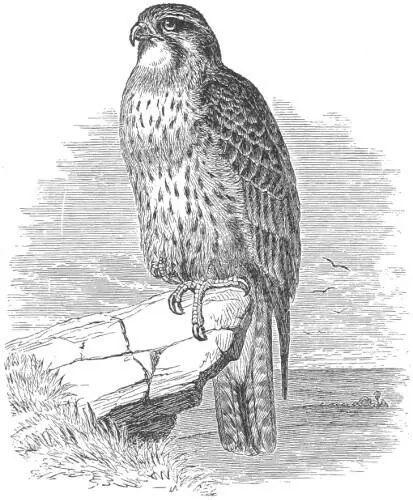
Falco polyagrus.
The var. polyagrus , compared with var. lanarius , is much darker, having, at all ages, the crown uniformly brown, with darker streaks, instead of having these streaks upon a white ground. The “mustache” is more distinct in the American bird, while in the European the bands on the tail are much more distinct, and the spots forming them are on the outer webs, as well as on the inner, instead of on the latter alone; the dark bars between the light spots are in the American bird much narrower and more numerous, and in the young the light ones come to the edge of the web, instead of being enclosed within the dark color. Two very young birds (i.e. in first perfect plumage) appear almost identical until closely examined, the chief differences being a lighter tint to the crown in the European, and heavier dark stripes on the breast, besides the peculiar character of the tail-spots, which are always distinctive. In shades of color, there is not the slightest difference.
I have seen no specimen of any of the Old World forms in the plumage corresponding to that transversely barred above, described here as the adult, though figures of the adult lanarius indicate a very similar plumage. The series of the latter race at my command is unfortunately limited to a very few immature specimens. One marked “ad.” (56,051, Hungary; Schlüter Coll.) measures as follows: Wing, 14.50; tail, 8.00; culmen, .83; tarsus, 1.90; middle toe, 1.80. Its colors are as described in the synopsis (p. 1429) for the young bird.
The var. mexicanus and var. jugger , which are both much darker, and more uniform in the coloring of the upper parts, than var. polyagrus , are more nearly alike; in fact, the only tangible difference that I can find between a specimen of the former in the Museum of the Boston Society of Natural History (No. 1,438, ♂, Juv. Lafr. Collection; “Mexico”) and two examples of the latter in the New York Museum, consist in the larger size of the var. jugger (see synopsis), besides its whiter cheeks and more isolated and distinct “mustache.” A direct comparison of these two races may show other tangible points of distinction, or, on the contrary, may show even these slight distinguishing features to be inconstant. The former result is, however, most reasonably to be expected.
National Museum, 9; Boston Society, 2; Philadelphia Academy, 4; Museum Comp. Zoöl. 1; G. N. Lawrence, 2; R. Ridgway, 5. Total, 23.

Habits. This is an exclusively western species, occurring from the valley of the Mississippi to the Pacific coast. Specimens have been obtained as far east as Illinois. Several others have been taken on the Upper Missouri and the Yellowstone Rivers, in Nebraska, at Fort Thorne, New Mexico, and on the Little Colorado River. A specimen was shot by Dr. Heermann on the Farallones, on the California coast; but Dr. Cooper thinks it rarely visits the coast border, though he several times saw, near San Diego, a bird which he supposed to belong to this species. At Martinez, in December, 1863, he succeeded in shooting one as it flew from its perch at the approach of the wagon in which he was riding.
It is said to extend its migrations in summer to the Upper Columbia, avoiding the densely forest-clad regions. Dr. Heermann saw a young unfledged individual at San Francisco, from which it may be inferred that a few may breed within the State.
The first individual of this species was taken by Dr. Townsend during his trip across the continent, in 1834. It was obtained among the mountainous regions of Oregon, near the sources of the Platte River. Mr. Cassin states that Dr. Heermann procured several specimens in the Sacramento Valley.
Mr. Cassin remarks that this species, except in its greatly superior size and strength, bears a very close resemblance to the well-known Jugger Falcon of India, a bird much used for the purposes of falconry.
Dr. Kennerly, who procured a single specimen of this species while his party was encamped on the Little Colorado, found it busily engaged in seeking its prey among the bushes that grew along the river-bank. It was shy, and was procured with difficulty.
Dr. Suckley speaks of this Hawk as not at all rare in Oregon. He procured a specimen of it at Fort Dalles, in the beginning of the winter of 1854–55, which had been killed in the act of carrying off a barn-yard fowl of about its own weight, and which it had just seized near the door of a dwelling-house,—an act demonstrative of a union of courage, ferocity, and strength inferior to none of its congeners.
Dr. Cooper characterizes this as one of the shyest of Hawks, as it is also one of the swiftest, flying with rapid flappings of the wings. It seems to prefer the borders of prairies, where it catches hares, quails, and even larger game.
Mr. Ridgway informs me that this Hawk was seen by him in Southern Illinois, near Mt. Carmel, September 27, 1871. It had been obtained once before within the limits of Illinois, but in the northwestern part of the State, at Rock Island, by I. Dickenson Sergeant, of Philadelphia, and presented by him to the Academy of Natural Science.
Its nest and eggs were taken in Utah by Mr. Ricksecker. I have no notes in regard to the former. A finely marked specimen of one of the eggs procured by him is in my cabinet. It measures 2.15 inches in length by 1.65 in breadth. It is of a somewhat less rounded-oval shape than are the eggs of the anatum . The ground-color is a rich cream, with a slightly pinkish tinge, and is beautifully marked with blotches of various sizes, shapes, and shades of a red-brown tinged with chestnut, and with occasional shadings of purplish. These are confluent about one end, which in the specimen before me chances to be the smaller one. It very closely resembles the eggs of the European F. lanarius .
An egg in the Smithsonian Collection (15,596), taken at Gilmer, Wyoming Territory, May 13, 1870, by Mr. H. R. Durkee, has a ground-color of pinkish-white, varying in two eggs to diluted vinaceous, thickly spotted and minutely freckled with a single shade of a purplish-rufous. In shape they are nearly elliptical, the smaller end being scarcely more pointed than the larger. They measure 2.27 by 1.60 to 1.65 inches. The nest was built on the edge of a cliff. Its eggs were also taken by Dr. Hayden while with Captain Raynolds, at Gros Vent Fork, June 8, 1860.
Falco , Mœhring, 1752. (Type, Falco peregrinus , Gm. = F. communis , Gm.)
Rhynchodon , Nitzsch, 1840. (In part only.)
Euhierax , Webb. & Berth., 1844. (Type, Falco —?)
Читать дальшеИнтервал:
Закладка:
Похожие книги на «A History of North American Birds, Land Birds. Volume 3»
Представляем Вашему вниманию похожие книги на «A History of North American Birds, Land Birds. Volume 3» списком для выбора. Мы отобрали схожую по названию и смыслу литературу в надежде предоставить читателям больше вариантов отыскать новые, интересные, ещё непрочитанные произведения.
Обсуждение, отзывы о книге «A History of North American Birds, Land Birds. Volume 3» и просто собственные мнения читателей. Оставьте ваши комментарии, напишите, что Вы думаете о произведении, его смысле или главных героях. Укажите что конкретно понравилось, а что нет, и почему Вы так считаете.
